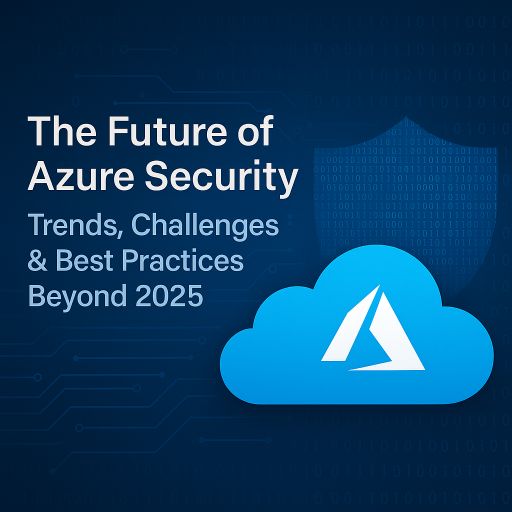Table of Contents
Introduction: The Evolution of Cloud Security
As we move beyond 2025, the landscape of Azure security continues to transform rapidly. Cloud adoption is accelerating, cyber threats are evolving, and organizations must embrace proactive security strategies to stay resilient.
Microsoft Azure, as a leading cloud platform, offers sophisticated security solutions, but with emerging technologies like AI-driven cyber threats, quantum computing, and Zero Trust advancements, businesses must future-proof their cloud environments.
This blog explores the future trends, challenges, and best practices shaping Azure security beyond 2025. From AI-powered security mechanisms to quantum-safe cryptography, here’s what security professionals need to anticipate.
Trend 1: AI-Driven Security Automation & Threat Intelligence
One of the most significant shifts in cloud security is the integration of artificial intelligence (AI) and machine learning (ML) into security frameworks. Cyber threats are evolving faster than traditional defenses can keep up with, making AI-powered security essential.
How AI Enhances Azure Security
🔹 AI-Based Threat Detection: Azure Sentinel & Microsoft Defender use ML to detect anomalies in real-time.
🔹 Automated Response Systems: AI automatically mitigates threats without manual intervention.
🔹 Behavioral Risk Analysis: AI assesses user patterns, detecting abnormal activities indicative of an attack.
Example: AI-Powered Incident Detection
Let’s say an attacker tries to access an Azure subscription using compromised credentials. Azure Security Center, backed by AI, recognizes the unusual login location and flags it as suspicious. Azure Sentinel then automatically blocks the activity and alerts security teams, preventing unauthorized access.
Future AI Capabilities
By 2026+, expect more autonomous security systems, where AI self-heals cloud environments by remediating vulnerabilities proactively. Enterprises must leverage AI-driven SOAR (Security Orchestration, Automation, and Response) to streamline incident responses and strengthen Azure security.
Trend 2: Zero Trust Architecture (ZTA) Becomes Standard
Zero Trust principles will become the default security model across all cloud environments. Traditional security models rely on perimeter-based defenses, but with remote work and multi-cloud adoption, businesses must verify trust continuously.
Key Zero Trust Enhancements
🔹 Microsegmentation: Dividing Azure workloads into isolated security zones.
🔹 Just-In-Time (JIT) Access: Preventing persistent access by granting privileges only when required.
🔹 Passwordless Authentication: Using FIDO2 security keys & biometrics for stronger authentication.
Implementing Zero Trust in Azure
Microsoft has been expanding Zero Trust across Azure AD Conditional Access and Microsoft Entra ID, allowing organizations to enforce strict identity verification before granting access.
Expect more granular ZTA capabilities beyond 2025, including continuous trust scoring models and AI-powered risk assessments embedded into Azure authentication workflows.
Trend 3: The Rise of Quantum-Safe Cryptography
Quantum computing poses a major cybersecurity threat, as it has the potential to break current encryption methods like RSA, ECC, and AES. Microsoft is already investing in quantum-resistant cryptographic algorithms to secure Azure workloads against quantum-based attacks.
Quantum-Safe Encryption Standards
🔹 Post-Quantum Cryptography (PQC): Encryption algorithms resistant to quantum computing attacks.
🔹 Quantum Key Distribution (QKD): Advanced cryptographic methods ensuring secure key exchanges.
🔹 Migration to Lattice-Based Cryptography: A promising approach to quantum-safe encryption.
Azure’s Quantum Security Roadmap
Microsoft is actively developing quantum-resistant security frameworks, ensuring Azure Key Vault & encryption services remain secure beyond 2025. Organizations must start preparing for post-quantum encryption today, adopting quantum-safe cryptographic algorithms early.
Trend 4: Cloud-Native Security & Automation Expansion
Security is shifting towards cloud-native protections, ensuring built-in security at the infrastructure level rather than relying on external solutions.
Cloud-Native Security Strategies
🔹 Automated Compliance Management: Using Azure Policy for continuous security enforcement.
🔹 Security-as-Code (SaC): Embedding security checks within DevOps workflows.
🔹 Infrastructure as Code (IaC) Security: Scanning Terraform, Bicep, and ARM templates for vulnerabilities.
Example: Automating Azure Security
# Enable encryption for all storage accounts automatically$storageAccounts = Get-AzStorageAccount foreach ($account in $storageAccounts) { Set-AzStorageAccount -ResourceGroupName $account.ResourceGroupName -AccountName $account.StorageAccountName -EnableHttpsTrafficOnly $true }By automating security enforcement, organizations can reduce misconfigurations and strengthen cloud defenses.
Challenges Facing Azure Security Professionals
Even with advanced security enhancements, new threats and complexities emerge beyond 2025. Security professionals must prepare for these hurdles:
🚨 Expanding Multi-Cloud Security Risks
🔹 Organizations adopting multi-cloud strategies must secure workloads across Azure, AWS & GCP.
🔹 Ensuring consistent security policies across diverse cloud platforms is increasingly difficult.
⚠️ AI-Powered Cyber Attacks
🔹 Cybercriminals weaponizing AI to bypass traditional security models.
🔹 Rise of automated phishing, deepfake impersonation, and AI-driven malware.
🔍 Compliance & Privacy Challenges
🔹 Stringent global regulations (GDPR, DPDP Act, U.S. privacy laws) increasing security demands.
🔹 Need for automated compliance enforcement and AI-driven privacy protection.
Best Practices for Future-Proofing Azure Security
Security professionals must adopt robust strategies to mitigate risks and stay ahead of evolving threats.
✅ Strengthen Identity & Access Management
🔹 Implement passwordless authentication via Microsoft Entra ID.
🔹 Adopt Just-In-Time (JIT) access control to minimize privilege exposure.
✅ Enhance Threat Detection with AI Security Models
🔹 Deploy AI-driven security analytics to detect unusual behaviors.
🔹 Use Azure Sentinel to automate threat intelligence.
✅ Secure Multi-Cloud Workloads
🔹 Standardize security policies across AWS, Azure, and GCP.
🔹 Use cross-cloud security automation tools for holistic protection.
✅ Shift to Quantum-Safe Cryptography
🔹 Begin transitioning to quantum-resistant encryption methods in Azure Key Vault.
🔹 Monitor Microsoft’s updates on quantum security frameworks for future adoption.
Conclusion: Preparing for the Future of Azure Security
Beyond 2025, Azure security will undergo significant transformations, driven by AI-powered automation, Zero Trust advancements, quantum-resistant encryption, and multi-cloud security demands. Organizations must proactively adopt future-ready security strategies to stay resilient against emerging cyber threats.
As cloud security professionals, staying ahead of trends, automation, and compliance shifts will be crucial in safeguarding workloads in Microsoft Azure & beyond.
🔥 What are your predictions for the future of Azure security? Let’s discuss in the comments! 🚀
Stay tuned for more insights in our 30 Days of Azure Security series!

